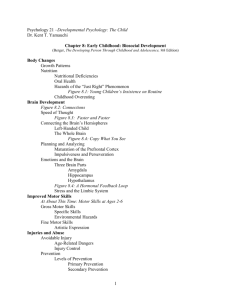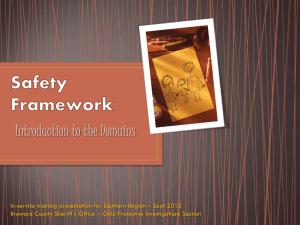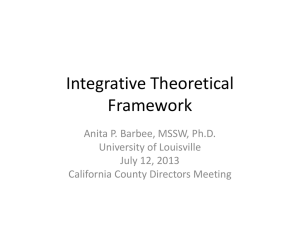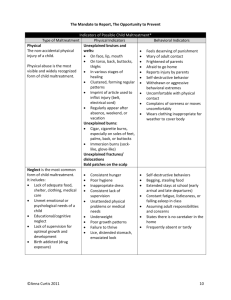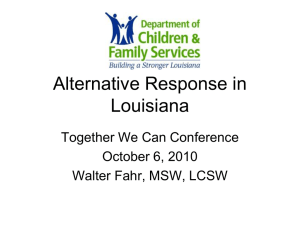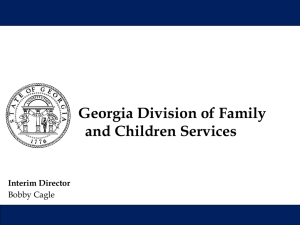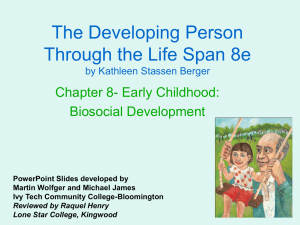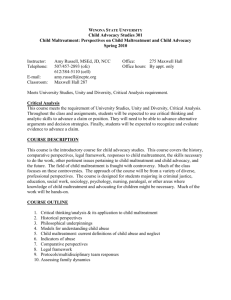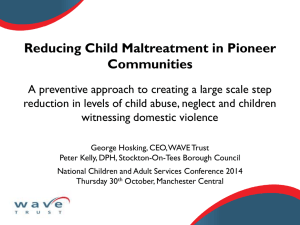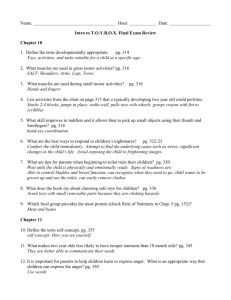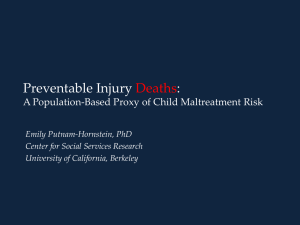Safety Versus Risk - Florida`s Center for Child Welfare
advertisement
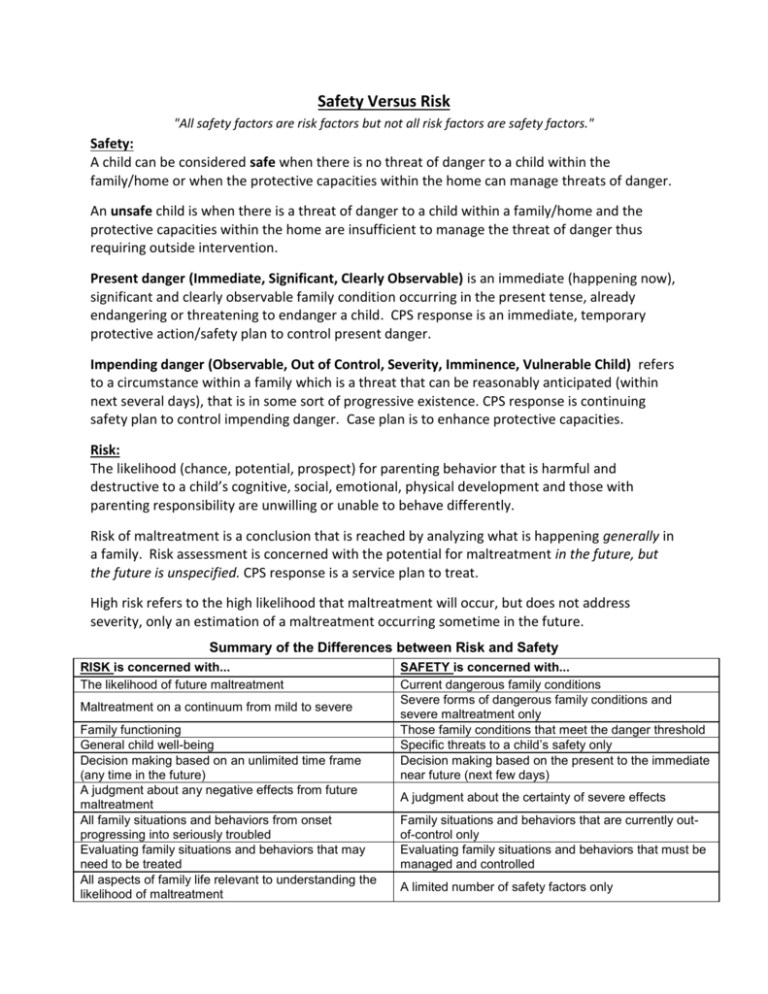
Safety Versus Risk "All safety factors are risk factors but not all risk factors are safety factors." Safety: A child can be considered safe when there is no threat of danger to a child within the family/home or when the protective capacities within the home can manage threats of danger. An unsafe child is when there is a threat of danger to a child within a family/home and the protective capacities within the home are insufficient to manage the threat of danger thus requiring outside intervention. Present danger (Immediate, Significant, Clearly Observable) is an immediate (happening now), significant and clearly observable family condition occurring in the present tense, already endangering or threatening to endanger a child. CPS response is an immediate, temporary protective action/safety plan to control present danger. Impending danger (Observable, Out of Control, Severity, Imminence, Vulnerable Child) refers to a circumstance within a family which is a threat that can be reasonably anticipated (within next several days), that is in some sort of progressive existence. CPS response is continuing safety plan to control impending danger. Case plan is to enhance protective capacities. Risk: The likelihood (chance, potential, prospect) for parenting behavior that is harmful and destructive to a child’s cognitive, social, emotional, physical development and those with parenting responsibility are unwilling or unable to behave differently. Risk of maltreatment is a conclusion that is reached by analyzing what is happening generally in a family. Risk assessment is concerned with the potential for maltreatment in the future, but the future is unspecified. CPS response is a service plan to treat. High risk refers to the high likelihood that maltreatment will occur, but does not address severity, only an estimation of a maltreatment occurring sometime in the future. Summary of the Differences between Risk and Safety RISK is concerned with... The likelihood of future maltreatment Maltreatment on a continuum from mild to severe Family functioning General child well-being Decision making based on an unlimited time frame (any time in the future) A judgment about any negative effects from future maltreatment All family situations and behaviors from onset progressing into seriously troubled Evaluating family situations and behaviors that may need to be treated All aspects of family life relevant to understanding the likelihood of maltreatment SAFETY is concerned with... Current dangerous family conditions Severe forms of dangerous family conditions and severe maltreatment only Those family conditions that meet the danger threshold Specific threats to a child’s safety only Decision making based on the present to the immediate near future (next few days) A judgment about the certainty of severe effects Family situations and behaviors that are currently outof-control only Evaluating family situations and behaviors that must be managed and controlled A limited number of safety factors only Six Domains of Information Collection 1. Extent of Maltreatment Type of maltreatment; Severity of the maltreatment, results, injuries; Maltreatment history, similar incidents; Describing events(what happened, hitting, pushing); Describing emotional and physical symptoms; Identifying child and maltreating parent 2. Surrounding Circumstances for Maltreatment How long has the maltreatment been occurring? Parental intent concerning the maltreatment; Whether parent was impaired by substance use, or was otherwise out-of-control when maltreatment occurred; parent's explanation of maltreatment and family conditions; parent's acknowledgement of maltreatment,; parent’s attitude; other problems connected with the maltreatment such as mental health problems *The first two (above) will be addressed by PI, so the CM should not continue to investigate these, but look at how the above information can provide information for the other four domains (below). 3. Child Functioning How does the child function on a daily basis? Include physical health, development; emotion/temperament; capacity for attachment; intellectual functioning; behavior; ability to communicate; self-control; educational performance; peer relations; behaviors that seem to provoke parent action; activities with family What is this child's vulnerability based on identified threat(s)? 4. Parent/Adult Functioning How does the adult function on a daily basis? Overall life management. Assessment/analysis of prior abuse/neglect history. criminal behavior, impulse control, substance use/abuse, violence/domestic violence, mental health, physical health, emotion/temperament, intellectual functioning; behavior- ability to communicate; self-control; education; peer and family relationships, employment; cultural norms; 5. Parenting General What are the overall, typical parenting practices used by the parents? Upbringing and influences on parenting; parenting style; parent's description of themselves as parent; reasons for being parent; satisfaction with being parent; history of parenting; expectations of child; parenting knowledge/skill; cultural influence on parenting 6. Discipline/Behavior Management What are the disciplinary approaches used by the parents and under what circumstances? purpose of discipline; what is parent expecting to achieve with chosen discipline?
